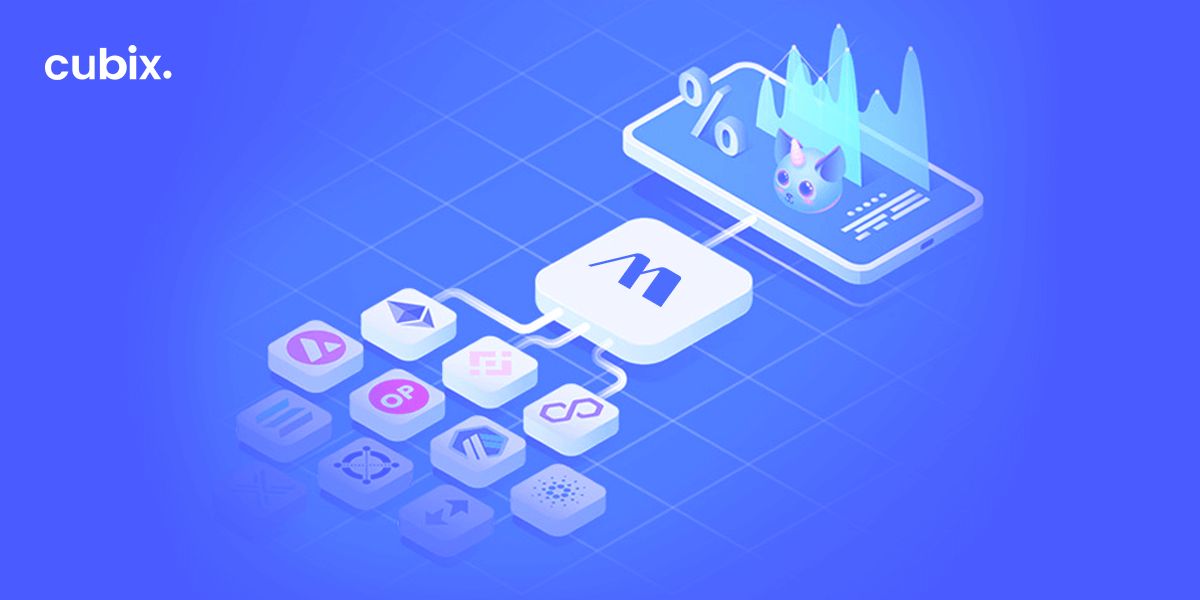The emergence of the internet has offered efficiency in one's lifestyle as every production sector cannot proceed without the accessibility of the internet. Moreover, individuals use the internet at home, in educational institutes, offices, cafes, and even on subways.
Undoubtedly, the internet is the supreme and leveraging technological advancement in human history.
So, what is Web 3.0? Why should one use it to develop their application, and what exactly will it serve? All of these concerns will be addressed by us shortly in this simple guide to the Web3 stack!!
What is Web3?
The simple guide to the Web3 stack features will sound like something out of a science fiction film. Aside from reading and writing, the programs can process various data simultaneously.
Semantic searching features are adopted for individuals in this decentralized web version. The search result in a semantic search will be even more appropriate and precise.
Peer-to-peer technology is the core of Web 3.0. As a result, the mediator will be eliminated. We will no longer rely on colossal database servers owned by a private corporation. Our sensitive data will be even more secure and more confidential. It also is a smart application-based web with enhanced and extra features. It's the ideal blend of technology and expertise.
While the "Simple Web" and "Social Web" are terms used to describe the first two versions of the internet, The phrase "Semantic Web" is chosen by professionals while defining the web3 stack.
Web3 Projects Example
If you're interested in learning more about the topic, below are some of the best web three examples currently available that will help us in defining the web3 stack. But, first, let's have a look:
Matcha
Matcha is a web3-based, P2P cryptocurrency exchange that has a lot of intriguing functions, such as the option to sell all digital currencies as an ETF (exchange-traded fund) to save time & expense while potentially reducing risk.
Uniswap
Uniswap is an open-source, P2P, and (ERC-20 Tokens) Ethereum-based cryptocurrency swapping mechanism. The protocol is built as a collection of persistent, non-upgradable smart contracts with anti-censorship, privacy, governance, and the ability to function without mediators.
Uniswap offers a web-based user interface that enables using the protocol to be a breeze. Over a 1/3 of the Defi market is controlled by Uniswap.
Aave
Aave is a decentralized and non-custodial cashflow market protocol that allows users to play banker and customer roles. In exchange for passive income, depositors give crypto assets, which are subsequently made accessible to borrowers as loans.
Consider Aave to be a blockchain-based bank that can operate as both a borrower and a lender, but only with digital assets rather than bank notes.
Also Read: How to Turn Your Website into a Mobile App
Why Develop in Web3?
Decentralized
Despite significant advancements in the field of financial technology (FinTech), transferring monetary assets has not always been straightforward. Privacy, high transaction fees, federal regulations, and unavailability in some areas of the world are all issues that Web Development Services strive to address.
Web3 is the latest iteration of the World Wide Web that features decentralized systems, semantic internet applications, universal cryptocurrency-powered DeFi, and community-owned content.
Openness
Censorship has been a significant concern in this age of internet users. Over time, governing bodies have misused their power, limiting access to some internet content based on political, socioeconomic, and societal disparities. Because there is no central controlling authority, no one can take advantage of decentralized systems for income or dominance.
Permissionless
One of the most pressing concerns on the modern web is web application authentication (the need to have multiple passwords on every different platform). Unfortunately, this is an unencrypted and time-consuming way of validation.
All you need to do to partake in the blockchain using decentralized applications (Dapps) to create a crypto wallet and link it to the application.
The Web 3 stack Explained
Let's consider the Web3 as a vehicle as it assists us in defining the web3 stack, then web3 libraries/dApps are the frames, smart contracts/blockchain are the core physical components, wallets are the driver's license, and the node is the gasoline that the car needs to function. So let's take a look at each one individually.
Web3 Libraries/dApps
We can easily interact with the blockchain, make transactions, and engage with smart contracts using the web3 stack libraries. Furthermore, we can create decentralized applications that reside on the blockchain or interact with it using web3 libraries like web3.js, ethers.js, and web3.py.
Smart Contracts
Smart contracts are computer programs that run on the blockchain. They are immutable and work within the blockchain. Solidity is the most commonly used programming language for smart contracts. Remix IDE is used by the vast majority of developers to code, compile, and deploy contracts.
Nodes/Web3 Providers
To get data from the blockchain, nodes or Web3 providers are required; nodes run a copy of the blockchain and are an important part of the interoperable web3 stack trend because smart contracts cannot be interacted with without nodes. They serve as a sort of entry point into the blockchain world.
QuickNode is a global network of powerful nodes. You can get flash access to blockchain data and send faster transactions using this worldwide network.
Wallets
On a blockchain, a wallet address is a person's identity and the location of the owner's various cryptocurrencies. When performing a writing operation on the blockchain, we must first verify the transaction and pay a fee to the network; this is easier by using a wallet, such as MetaMask. Alternatively, you can make your own Ethereum address/wallet in JavaScript, Python, Ruby, Go, or PHP.
Read More: How to Create Content in the Metaverse?
Web3 Protocols List
The protocol stack covers different consensus algorithms, participatory prerequisites, Virtual Machines, and other viewpoints. So, let's look at them more closely.
Consensus Algorithms
Consensus algorithms are used in blockchains to verify that all nodes commit. The problem is to find a solution to the well-known consensus problem, especially if there are multi-agent systems and distributed computing protocols in the network. To make this a reality, the algorithm must assume that a few nodes will be inaccessible and that the network will experience data leakage.
As a result, the algorithm becomes a fault-tolerant machine. Making it fault-tolerant from the beginning will improve the network's efficiency because it will be ready for it even if it doesn't happen.
Side Chains
Some users mix upstate streams and sidechains. However, there is a great disparity. Sidechain is a new type of evolving platform that enables tokens or other assets to be transferred from the parents' blockchain to a completely distinct blockchain and return.
Sidechain provides a lot of potential to the developers. Within the sidechain, developers can easily create decentralized applications without affecting the main chain in any way. However, everyone on the network will be able to benefit from the apps' effectiveness.
They are self-contained cells of various blockchain networks responsible for their own security. As a result, if they are hacked. Then only one of the side chains is impacted; others will remain protected.
Participation Requirements
This refers to the distinct forms of blockchain networks that impact the web3 IT stack. The web3 blockchain's new decentralized platform contains two types of architecture.
The first is an open or permissionless blockchain, in which any user can join the network without having to meet any restrictions. As a result, they may quickly access the protocols provided by the network.
On the other hand, private or restrictive networks need participants to agree to particular rules to join as members and utilize the network's protocols or other perks.
Virtual Machines
The virtual machines' primary goal is to preserve confidentiality and process suspicious code from all systems on the internet. Simply said, EVM is now available to protect against the most prevalent risk in the crypto world: a denial-of-service attack.
This type of cyber-attack is extremely dangerous since it might render a network's resources inaccessible to its users. However, it may also assure that no programs conflict with one another, ensuring that everything flows efficiently.
This environment was built to provide an execution environment for smart contracts, allowing users to take advantage of the service.
Technologies Required for Web3
The Ethereum and Solidity manuals are the best places to start. They will teach you the essentials of grasping the most popular blockchain platform and how to create a smart contract after you've finished reading them.
Solidity's learning curve till now is feasible for most developers, as it is nearly identical to C++ and Java. However, with the Rust programming language, smart contracts are now being written in a broader sense.
You have to become familiar with a new interoperable web3 stack trend and languages, such as Remix, and understand how to implement it to the Ethereum Virtual Machine or some other equivalent execution mechanism for the blockchain of your choice. Then you'll need to understand how to sign transactions, with MetaMask appearing as an emerging enterprise tool for this task.
To put it another way, to develop or use most Web3 applications today, you'll need to learn new skills, establish a crypto wallet, and pay the unstable "gas" costs necessary to complete operations on the Ethereum blockchain, all of which might be intimidating to newcomers.
Ready to Get Your Web3 App Developed?
Web3 is the elevating and potential changer in the internet's growth. Web3, at its foundation, is a vision for a more accessible, decentralized, and secure web, made possible by advancements in technologies like blockchain and machine learning. The possibilities appear endless, specifically in the context of the entertainment and application development industry.
Although the entire scope of the web3 stack influences the future of app development that is still to be revealed, Web3 is set to have an essential impact on a number of crucial facets of the various sectors.
You have to become familiar with a new development ecosystem, such as Remix, and understand how to implement it to the Ethereum Virtual Machine or some other equivalent execution mechanism for the blockchain of your choice. Then you'll need to understand how to sign transactions, with MetaMask appearing as an emerging enterprise tool for this task.
To put it another way, to develop or use most Web3 applications today, you'll need to learn new skills, establish a crypto wallet, and pay the unstable "gas" costs necessary to complete operations on the Ethereum blockchain, all of which might be intimidating to newcomers.
Read More: Latest Trends in Mobile App Development in 2022
Conclusion
Undoubtedly, Web3 emergence is still a new concept to many of us, and therefore it will take some time for worldwide people to get familiar with it. It is an internet controlled by its users consisting of the protocols, architecture, user applications, and access points listed above. Web3's strength resides in its adaptability and accessibility, not its governance.
This essentially implies that the interoperable web3 stack trend may be joined in an infinite number of ways to generate new and intriguing use cases. This characteristic we anticipate will result in an explosion of novel game-changing applications.
While the structure and layers we described in our simple guide to the Web3 stack are likely to remain constant, we anticipate significant changes in the programs and possibilities inside them in the upcoming era.
Connect with our tech-savvy pro technical team to get more professional ideas.

